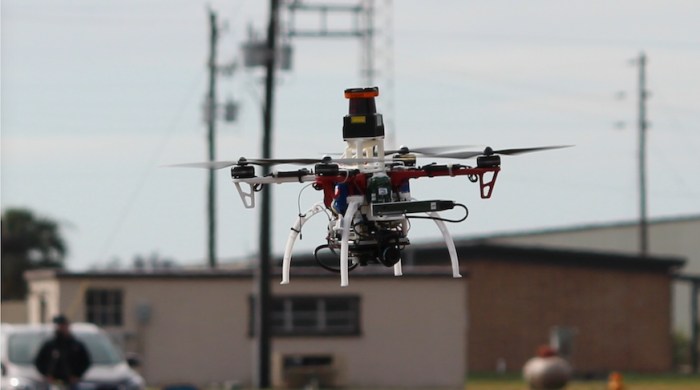Every year landmines kill and maim over 20,000 people — most of whom are women, children and the elderly — according to the United Nations. The Mine Kafon Drone aims to put an end to this devastating loss of life by clearing some of the 100 million landmines leftover from past conflicts. The drone, developed by the Mine Kafon Foundation, maps, detects and detonates landmines from a safe distance. The six rotor MKD first maps dangerous areas, then the metal detector geotags mines and finally the robotic arm detonates the explosives from a safe distance. The gadget is believed to be up to 20 times faster and up to 200 times cheaper than traditional demining techniques. Mine Kafon Foundation founder Massoud Hassani explains how this minesweeper could clear the world’s landmines in under 10 years. Why did you decide to develop the Mine Kafon Drone?
Growing up on the edge of Kabul in a little town called Qasaba in Afghanistan, Massoud and Mahmud Hassani, the brothers behind the Mine Kafon Drone project, experienced the horrors of landmines from an early age. These experiences fueled Massoud to develop a solution for a safe and smart solution to detect and clear landmines. Following Massoud’s first successful Kickstarter campaign in 2013, the Mine Kafon Foundation was founded. The Mine Kafon Foundation is an R&D organization based in the Netherlands. In the past three years, Massoud and Mahmud have been raising awareness by giving lectures around the world and developing new approaches on how to fight landmines in different environments. In this way, they have crowdsourced many engineers and designers from all over the world and invited them to collaborate and volunteer on this humanitarian project. So far, we have already developed several working prototypes of the Mine Kafon Drone. We have performed tests with the Dutch Ministry of Defense on their territory and spoke with their experts on demining difficulties. The Mine Kafon Drone is now ready for its next step. How could this drone clear all the world’s landmines in less than 10 years?
We want to draw a mapping grid over all the countries that are affected by landmines. This will be done with the Mine Kafon mapping drone. To give us all the info we need to start with the detection part, then we start detecting and detonating. At the moment we are preparing a pilot in a 150 square km field. That’s about the size of 37,000 football stadiums. First we do the 3D mapping part with only 10 drones working 24/7 for a period of two months. Then we apply the detection drones. We will need about 50 Mine Kafon Drones with metal detectors to detect the fields cm by cm for six months. These drones will fly 24/7 over this whole period of time. The landscape is like a mine-filled dessert but in less then a year this landscape can be a green zone. At the moment there are about 60 countries affected and we can start with 100 drones per country.
Why is it important to clear all the landmines around the world?
There’s a hidden problem in the world, both literally and figuratively, that something as deadly as a landmine can be overlooked and forgotten because it’s out of sight. Although the developed world seems to have been mostly cleared of this problem, its deadly and mutilating effects are constantly experienced by civilians in over 60 nations. The numbers seem daunting, with more than a 100 million live landmines worldwide and nearly a billion people at risk, but humanity always invents solutions to problems and especially to problems that we have put in place. With a collective and humanitarian effort, we can defuse this hazard, which will enable the land to become useful again. There are landmines where farms ought to be; there are land mines where sports fields and parks ought to be; there are land mines where educational and medical facilities ought to be. With the current technology, as employed by NATO forces, landmines around the globe can be cleared in 1100 years. The Mine Kafon Foundation wants to reduce this period to just 10 years.
Why is the Mine Kafon Drone better than traditional demining systems?
Traditional and existing demining systems are mostly operated by people or animals. It is very slow and time consuming. Of course it is also very dangerous. MKD offers a number of crucial advantages over the products currently used by demining organizations. The MKD is completely casualty-free and operates at a reduced cost to traditional methods.
Its modular system can be enhanced through the addition of sensors and tools, allowing the MKD to perform a wide variety of tasks.
The ability to map the area covered by the demining operation creates a wealth of information to aid the decision-making processes for ongoing operations.
The planning of demining procedures is made easier by the scanning process, allowing information to be gathered about at-risk areas before the demining begins.
The data from each operation is collected and analyzed in a structured and systematic way.
How it works:
The Mine Kafon Drone (MKD) offers an innovative solution to landmine removal, providing a reliable demining system that delivers accurate updates and information on mine clearing operations. The Mine Kafon Drone flies over dangerous areas to map, detect and detonate landmines from a safe distance. The drone works autonomously equipped with three separate interchangeable robotic extensions. These three methodologies combined makes the MKD up to 20 times faster than traditional demining technologies. As well as being safer, it also up to 200 times cheaper.
1. Mapping
First the drone flies over the whole field with an aerial 3D mapping system to identify all the dangerous areas with GPS waypoints.
2. Detection
Equipped with a robotic metal detecting arm, the MKD hovers above the ground at approximately four centimeters to detect mines. Every detected mine is geotagged on the operator’s system to construct a map of known mine locations. 3. Destruction
For the final phase of the process the MKD, attached with a robotic gripping arm, places a small detonator on every detected mine. The land mine is then detonated from a safe distance using a timer. -Daniel Casillas

















